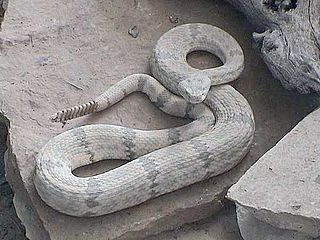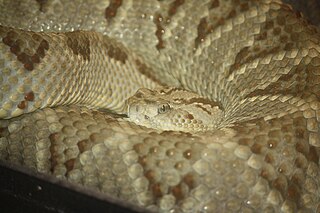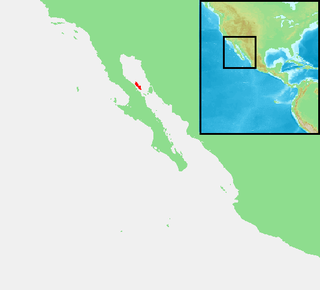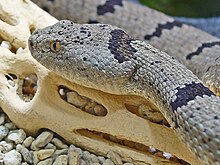
The black-tailed rattlesnake is a venomous pit viper species found in the southwestern United States and Mexico. Four subspecies are currently recognized, including the nominate subspecies described here.

Crotalus lepidus is a venomous pit viper species found in the southwestern United States and northern central Mexico. Four subspecies are currently recognized, including the nominate subspecies described here.

Crotalus basiliscus, known as the Mexican west coast rattlesnake, Mexican green rattler, and also by other names, is a species of pit viper in the family Viperidae. The species is endemic to western Mexico. Like all other pit vipers, it is venomous. The specific name, basiliscus, is derived from the Greek word for king, βασιλισκος, and alludes to this snake's large size and potent venom. No subspecies are currently recognized.

Crotalus helleri or Crotalus oreganus helleri, also known commonly as the Southern Pacific rattlesnake, the black diamond rattlesnake, and by several other common names, is a pit viper species or subspecies found in southwestern California and south into Baja California, Mexico, that is known for its regional variety of dangerous venom types. It is sometimes considered a subspecies of Crotalus oreganus.

Crotalus viridis is a venomous pit viper species native to the western United States, southwestern Canada, and northern Mexico. Currently, two subspecies are recognized, including the prairie rattlesnake, the nominate subspecies, and the Hopi rattlesnake.

Crotalus mitchellii is a venomous pit viper species in the family Viperidae. The species is endemic to the Southwestern United States and adjacent northern Mexico. The species was named in honor of Silas Weir Mitchell (1829–1914), an American medical doctor who also studied rattlesnake venoms. Five subspecies are currently recognized, including the nominate subspecies described here.

Crotalus enyo, commonly known as the Baja California rattlesnake or Lower California rattlesnake, is a pit viper species native to the coast and islands of northwestern Mexico. Like all other pit vipers, it is venomous. Three subspecies are currently recognized, including the nominate subspecies described here.

Crotalus ravus, commonly known as the Mexican pigmy rattlesnake or Mexican pygmy rattlesnake, is a venomous pit viper species, found only in Mexico. Three subspecies are currently recognized.

Crotalus simus is a venomous pit viper species found in Mexico and Central America. The specific epithet is Latin for "flat-nosed", likely because its head is blunt compared with lanceheads (Bothrops). Three subspecies are recognized, including the nominate subspecies described here.

Crotalus atrox tortugensis is a venomous pit viper subspecies found only on Tortuga Island in the Gulf of California.

The Great Basin rattlesnake is a venomous pit viper species found in the Great Basin region of the United States.

Crotalus intermedius is a pit viper species found in central and southern Mexico. Like all other pit vipers, it is venomous. Three subspecies are currently recognized, including the nominate subspecies described here.
Crotalus intermedius omiltemanus is a venomous pitviper subspecies found in Mexico in the state of Guerrero.

Crotalus intermedius gloydi is a subspecies of venomous pitviper in the family Viperidae. The subspecies is endemic to Mexico in the states of Oaxaca and Puebla.

Crotalus pricei is a species of venomous snake, a pit viper in the family Viperidae. The species is endemic to the southwestern United States and northern Mexico. Two subspecies are recognized.

Crotalus stejnegeri, commonly known as the Sinaloan long-tailed rattlesnake or just long-tailed rattlesnake, is a venomous pit viper species in the family Viperidae. The species is native to western Mexico. There are no recognized subspecies.

Crotalus cerastes cercobombus, commonly known as the Sonoran Desert sidewinder or Sonoran sidewinder, is a pitviper subspecies found in the eastern part of the Sonoran Desert in the southwestern United States and northwestern Mexico. Like all pitvipers, it is venomous. The subspecific epithet means buzzertail.

Crotalus angelensis, or the Ángel de la Guarda Island speckled rattlesnake, is a pitviper species endemic to Isla Ángel de la Guarda in the Gulf of California, Mexico. Like all other pitvipers, it is venomous. It is sometimes treated as a subspecies of Crotalus mitchellii.
Crotalus mitchellii muertensis is a venomous pitviper subspecies endemic to El Muerto Island, Mexico. It is sometimes treated as a full species, Crotalus muertensis.
Crotalus ruber lucasensis, the San Lucan diamond rattlesnake, is a venomous pitviper subspecies found in Mexico in the Cape region of lower Baja California.


















